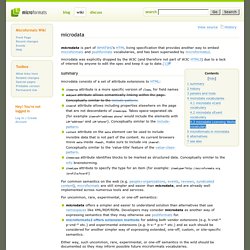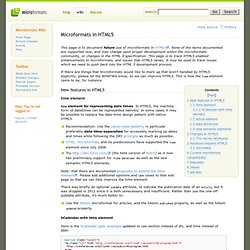

Microdata, Microformats, and RDF — Edward O’Connor. Microdata, semantic markup for both RDFers and non-RDFers - benj. RDF-in-HTML could have been so simple.

There's been a whole lot of discussion around Microdata, a new approach for embedding machine-readable information into forthcoming HTML5. What I find most attractive about Microdata is the fact that it was designed by HTMLers, not RDFers. It's refreshingly pragmatic, free of other RDF spec legacy, but still capable of expressing most of RDF. Unfortunately, RDFa lobbyists on the HTML WG mailing list forced the spec out of HTML5 core for the time being.
This manoeuver was understandable (a lot of energy went into RDFa, after all), but in my opinion very short-sighted. But no, Microdata wasn't developed by an RDF group, so they voted it out again. Here is a short overview of RDF features supported by Microdata: I've been using Microdata in two of my recent RDF apps and the CMS module of (ahem, still not documented) Trice, and it's been a great experience. Microdata: Extracted RDF: @base < @prefix foaf: < . Microdata. Microdata is part of WHATWG's HTML living specification that provides another way to embed microformats and poshformats vocabularies, and has been superseded by microformats2. microdata was explicitly dropped by the W3C (and therefore not part of W3C HTML5) due to a lack of interest by anyone to edit the spec and keep it up to date.[1] summary microdata consists of a set of attribute extensions to HTML: itemprop attribute is a more specific version of class, for field names subject attribute allows semantically linking within the page.

For common semantics on the web (e.g. people+organizations, events, reviews, syndicated content), microformats are still simpler and easier than microdata, and are already well implemented across numerous tools and services. For uncommon, rare, experimental, or one-off semantics: microdata offers a simpler and easier to understand solution than alternatives that use namespaces like XML/RDF/RDFa. History microdata didn't happen overnight. Parsers and tools. In HTML 5. This page is to document future use of microformats in HTML5.

None of the items documented are supported now, and may change upon proper development within the microformats community, or changes in the HTML 5 specification. This page is to track HTML5 enabled enhancements to microformats, and issues that HTML5 raises. It may be used to track issues which we need to push back into the HTML 5 development process. If there are things that microformats would like to mark up that aren't handled by HTML5 explicitly, please let the WHATWG know, so we can improve HTML5. This is how the time element came to be, for instance. New features in HTML5 time element time element for representing date times. Recommendation: Use the value-class-pattern, in particular preferably date-time-separation for accessibly marking up dates and times while following the DRY principle as much as possible. Note: that there are documented proposals to extend the time element. hCalendar with time element article element.
Microdata, semantic markup for both RDFers and non-RDFers - benj. What You Can't Do with HTML5 Microdata. Update: Fixed a couple of errors in the microdata code. The HTML5 microdata proposal has hit the web, just days before Google announced its support for RDFa (or at least one vocabulary encoded using RDFa attributes). These are, indeed, “interesting times” for the semantic web. Now, if you’re one of those weirdos who want to embed RDF triples within your web pages, what you’re going to care about is whether you can use microdata to do it. Those of us who have been using RDFa in anger, rather than in toy examples, know that it can be hard to map a particular set of RDF statements onto HTML content.
I thought I’d take a look to see just what it would be like to create particular RDF with the HTML5 microdata proposal. Basics On the face of it, you can express any triple in microdata because a triple like this (Turtle): < . can always, and anywhere, be expressed with (HTML5): while a triple like: < "value" . can be expressed with: It’s not just the URIs that are long-winded, by the way. Datatypes.